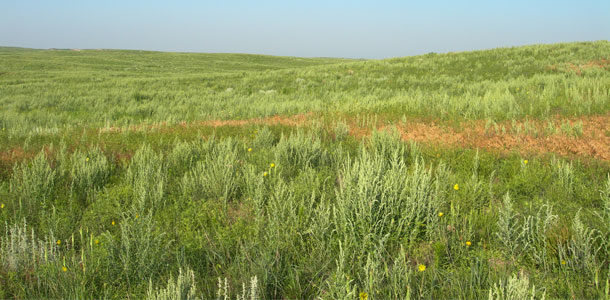This included low vigor and poor reproduction of perennial grasses or actual death loss of desirable grasses. When more average precipitation and other ideal environmental conditions came together in 2013, the result was an explosion of weed species across many pastures and rangelands.
Where do the weeds come from?
Many of the weed species that flourished this past year were annual species growing from seed at or below the soil surface.
Although viability of seed declines over time, longevity of seed in the soil seedbank can range from just two to three years for some species to 10, 20 or even more years for others.
In 2013, areas and rangeland types that saw the abundance of annual weeds had the ideal environmental conditions come together for the germination and growth of these plants.
This included the combination of precipitation, temperature, weakened pasture grasses and an adequate seedbank. Many perennial weeds, western ragweed for example, also responded positively to the greater precipitation observed in 2013.

Table 1 shows recent years and long-term average pasture production by plant group type for an upland Nebraska Sandhills range site. Most noticeable in 2013 was lower productivity of cool-season and warm-season grasses and the high productivity of the forb (annual and perennial broadleaf) group.
It can be said that weed increases in introduced pastures and native-range plant communities are a response to some type of disturbance.
For native range, this disturbance often means a lower ecological or successional stage for that plant community. Drought is a disturbance and can be viewed as similar to other disturbances such as long-term heavy grazing; a late, severe growing season freeze or hail storm; a poorly timed wildfire; or even lightly disking that range site.
Good weeds and bad weeds
A common definition of a weed is a plant that is not valued where it is growing, and it is often vigorous and tends to outcompete desirable plants.
This includes species that may be annuals or perennials and those that are native to a region or introduced from another part of the world.
Native rangelands typically have a diversity of plant species that include grasses and broadleaf herbaceous plants (forbs).
Sometimes many of these forbs species are mistakenly placed into the weed category but are actually a natural part of the plant community. Unlike weeds, they typically are not competitive or spread extensively. Many have good forage value, benefit wildlife or may be a legume.
For many pasture and rangeland managers, the sight of the rapidly growing weeds in the early summer of 2013 was a disheartening sight.
There can be valid concerns of soil moisture use and competition presented by weeds. However, many weed species are palatable and have good forage value, particularly at a younger growth stage.
Livestock grazing weeds was a common sight during 2013 and reduced grazing pressure on recovering grasses. Additionally, remaining weed growth at the end of the season becomes valuable residue and litter that is very important for protecting the soil and increasing water infiltration.
Weed control
Before implementing a weed control program, it is important to identify the target species and know its growth pattern and other characteristics, such as whether it is an annual or perennial.

It is likely that the abundance of annual weeds will be markedly less in 2014 as perennial grasses recover and increase in density. For introduced or seeded grass pastures, herbicide use may increase desirable grass recovery and productivity.
Managers might also evaluate the overall density of the grass stand and may consider complete renovation of that pasture, or in some cases use herbicides to control weeds and then interseed grasses and legumes to thicken the stand.
There is a relatively good selection of herbicides that are effective and are labeled for range and pasture. Different herbicides may provide varying levels of control on certain weed species, particularly for some aggressive perennial weeds.
Carefully review herbicide information to find the best herbicide for the target weed. Herbicide application rate and timing are essential in obtaining satisfactory levels of weed control.
These recommendations are found in the herbicide label. In many Great Plains areas, May and June is a popular time of year to target both annual and perennial broadleaf weeds.
Herbicide application in early fall is also effective for several perennial weeds. As an alternative to herbicides, shredding or mowing of many annual weed species will reduce their competitiveness. Mowing done just prior to the time of flowering will also reduce weed seed production.
On native rangeland pastures, careful consideration should be given before herbicide application on a large scale. Herbicides that control broadleaf weedy species will likely damage a variety of native non-weedy, broadleaf plants (forbs) and shrubs that are an important part of that plant community.
This includes those that might be native legumes or have considerable forage value. When there is a cyclic abundance of annual weeds, as we have seen following drought, using proper grazing management on those pastures to facilitate grass recovery is often all that needs to be done.
There are exceptions though, such as when localized areas or patches of aggressive perennial species have developed and are likely to spread. Managers should also be observant for plants that are potentially poisonous to livestock or noxious weeds. FG
PHOTO
PHOTO 1: In the summer of 2013, annual weeds including lambsquarters and other weedy annual species dominate this native rangeland site. Prior to the 2012 drought, this site was dominated by a mixture of desirable native grasses.
PHOTO 2: Annual weeds thrive where grass density became thin due to death loss caused by severe drought. Photos provided by Jerry Volesky.
Jerry Volesky
Range and Forage Specialist
University of Nebraska –Lincoln
West Central Research and Extension Center










